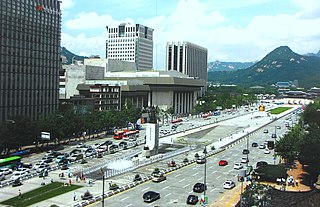
Sejong the Great was the fourth king of the Joseon dynasty of Korea. He was the third son of King Taejong from Queen Wongyeong, and was designated as Crown Prince after his older brother, Grand Prince Yangnyeong, was stripped of his title. He ascended to the throne in 1418, but during the first four years of his reign, Taejong governed as regent and executed Sejong's father-in-law, Sim On, and his close associates.

South Chungcheong Province, also known as Chungnam, is a province of South Korea. South Chungcheong has a population of 2,059,871 (2014) and has a geographic area of 8,204 km2 located in the Hoseo region in the southwest of the Korean Peninsula. South Chungcheong borders the provinces of Gyeonggi to the north, North Chungcheong, Sejong Special Autonomous City, and Daejeon Metropolitan City to the east, and North Jeolla to the south.

Sejong Center for the Performing Arts is the largest arts and cultural complex in Seoul, South Korea. It has an interior area of 53,202m². It is situated in the center of the capital, on Sejongno, a main road that cuts through the capital city of the Joseon Dynasty. The center took 4 years to complete, opening in 1978. It was "built as a cultural center for Seoulites." It currently contains one of the biggest pipe organs in Asia.

Sejongno, also known as Sejong-daero, is a street that runs through Jongno-gu in downtown Seoul. It is named after King Sejong the Great of Joseon. The street is 600 meters in length, but due to its central location it is of great symbolic importance. It points north to Gwanaksan and Bukhansan (Mountains), and the Joseon Dynasty palace, Gyeongbokgung. It is also of historical significance as the location for royal administrative buildings and features statues of the Admiral Yi Sun-sin of Joseon Dynasty and King Sejong the Great of Joseon.

The King Sejong Station is a research station for the Korea Antarctic Research Program that is named after King Sejong the Great of Joseon (1397–1450).

The Sejong the Great-class destroyers, also known as KDX-III, are three guided missile destroyers of the Republic of Korea Navy (ROKN). The ROKN has deployed three ships with an option for three more which was taken up in December 2013.

The Ministry of Trade, Industry and Energy (MOTIE) is a branch of the South Korean government. It is concerned with regulating some economic policy, especially with regard to the industrial and energy sectors. The ministry also works to encourage foreign investment in Korea. The current minister is Sung Yun-mo.

The Ministry of Economy and Finance oversees the financial policies of the South Korean government. It publishes a monthly report on the national economy, known as the "Green Book." The current minister is Hong Nam-ki. The headquarters is in the Sejong Government Complex in Sejong City.

Jongno District is a district in central Seoul, South Korea. It takes its name from a major local street, Jongno, which means "Bell Road".

Gwangjin District (Gwangjin-gu) is one of the 25 wards (gu) of Seoul, South Korea. It is located on the north bank of the Han River, to the eastern end of Seoul. It was created from neighboring Seongdong District in 1995.

Sejong, officially the Sejong Special Self-Governing City, is a special self-governing city and de facto administrative capital of South Korea.

Korea University Sejong Campus is Korea University's second campus. It was established in Jochiwon, Yeongi County(later annexed to Jochiwon District of Sejong City, the governmental capital of South Korea), South Korea in 1980. Korea University Sejong Campus is a leading research oriented one. The campus consists of the Biomedical Campus in Osong Bio-health technopolis established by Korea's Ministry of Health & Welfare, New Research Campus in Sejong City which is established as Korea's new government district Six colleges and schools in Sejong Campus are part of the twenty schools of Korea University.

Sejong University is a private university located in Seoul, South Korea known for its standing in hospitality and tourism management, dancing, animation and rhythmic gymnastics. Founded as the Kyung Sung Humanities Institute, it was renamed in 1978 to its present name in honor of Sejong the Great, the fourth king of the Joseon Dynasty and overseer of the creation of the Korean alphabet Hangul.

The Ministry of Education is a cabinet-level division of the government of South Korea. It was created on March 23, 2013. It should not be confused with seventeen regional Offices of Education which heads, Superintendents, are directly elected in local elections.

The Ministry of Land, Infrastructure and Transport (MOLIT) is a cabinet-level division of the government of South Korea. Its headquarters is in the Sejong Government Office in Sejong City.
National Route 43 is a national highway in South Korea connecting Sejong City to Kosong County. It was established on 31 August 1971.
The Sejong–Pocheon Expressway, is an expressway in South Korea, connecting Anseong to Guri, Seoul, Namyangju, Uijeongbu and Pocheon.

Yeoju FC is a South Korean football club based in the city of Yeoju. The club is a member of the K4 League, a semi-professional football league in South Korea.